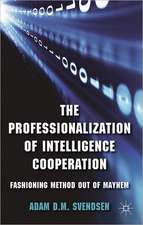An Essay on Strategy: as it Affects the Achievement of Peace in a Nuclear Setting
Autor R.R. Neilden Limba Engleză Paperback – apr 1990
Preț: 413.45 lei
Nou
Puncte Express: 620
Preț estimativ în valută:
79.12€ • 84.60$ • 65.96£
79.12€ • 84.60$ • 65.96£
Carte tipărită la comandă
Livrare economică 18 aprilie-02 mai
Preluare comenzi: 021 569.72.76
Specificații
ISBN-13: 9780333529874
ISBN-10: 0333529871
Pagini: 163
Ilustrații: XI, 163 p.
Dimensiuni: 140 x 216 x 10 mm
Greutate: 0.23 kg
Ediția:1990
Editura: Palgrave Macmillan UK
Colecția Palgrave Macmillan
Locul publicării:London, United Kingdom
ISBN-10: 0333529871
Pagini: 163
Ilustrații: XI, 163 p.
Dimensiuni: 140 x 216 x 10 mm
Greutate: 0.23 kg
Ediția:1990
Editura: Palgrave Macmillan UK
Colecția Palgrave Macmillan
Locul publicării:London, United Kingdom
Cuprins
Part 1: the importance of theory. Part 2 The political level: political aims and military means; different settings; ends and means in the classical setting; ends and means in a nuclear setting; stability; feedback; terminology; alternative strategies - non-nuclear forces; the distinction between offence and defence; the choice between offensiveness and defensiveness; the interaction of defensive and offensive strategies; the implications for balance and force levels; ways to mutual defensive superiority; the more-than-two country problem; nuclear weapons on one side; the nuclear setting; balance and nuclear weapons. Part 3 The nuclear level: the acceptance of stalemate and its implications; the pursuit of political advantage; nuclear weapons only; game theory; escalation; raising the risk; escalation dominance; nuclear plus non-nuclear weapons; extended deterrence; more than two countries. Part 4 The sub-nuclear level: origins; the trend of technology and firepower; the implications of increased accuracy; area weapons; classical laws; the requirements of a defensive structure; air forces; navies; evidence from non-aligned countries; evidence from modelling and exercises; the efficacy of denial and retaliation; the transition to defensiveness; the one-sided case - conclusion; the two-sided case; the approach to restructuring; the out of area problem. Part 5 The implementation of a strategy: three methods of implementation; the primacy of strategy; the objectives of negotiation; obstacles to change; offensive aims. Part 6 Interpretation of the period since 1945: military doctrine; Soviet and WTO non-nuclear doctrine; United States/NATO non-nuclear doctrine; nuclear doctrine; the United States; strengthening deterrence; the pursuit of balance; the Soviet Union; the lesser nuclear powers; disarmament and arms control. Part 7 The present position and the policy alternatives: Soviet and WTO policy; NATO policies; arms negotiations. Appendices: Disarmament negotiations before 1945: negotiations before 1914 - the background, the naval arms race, the disarmament movement, the Hague conferences; inter-war negotiations - the background, the approach to disarmament, naval disarmament, general disarmament, qualitiative disarmament, the lessons.













